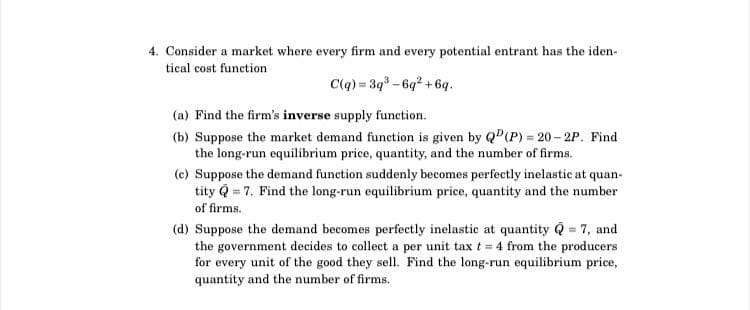4. Consider a market where every firm and every potential entrant has the iden- tical cost function C(q) = 3q³-6q² +6q. (a) Find the firm's inverse supply function. (b) Suppose the market demand function is given by QP (P) = 20-2P. Find the long-run equilibrium price, quantity, and the number of firms. (c) Suppose the demand function suddenly becomes perfectly inelastic at quan- tity Q = 7. Find the long-run equilibrium price, quantity and the number of firms. (d) Suppose the demand becomes perfectly inelastic at quantity Q = 7, and the government decides to collect a per unit tax t = 4 from the producers for every unit of the good they sell. Find the long-run equilibrium price, quantity and the number of firms.
4. Consider a market where every firm and every potential entrant has the iden- tical cost function C(q) = 3q³-6q² +6q. (a) Find the firm's inverse supply function. (b) Suppose the market demand function is given by QP (P) = 20-2P. Find the long-run equilibrium price, quantity, and the number of firms. (c) Suppose the demand function suddenly becomes perfectly inelastic at quan- tity Q = 7. Find the long-run equilibrium price, quantity and the number of firms. (d) Suppose the demand becomes perfectly inelastic at quantity Q = 7, and the government decides to collect a per unit tax t = 4 from the producers for every unit of the good they sell. Find the long-run equilibrium price, quantity and the number of firms.
Chapter12: The Partial Equilibrium Competitive Model
Section: Chapter Questions
Problem 12.9P
Related questions
Question

Transcribed Image Text:4. Consider a market where every firm and every potential entrant has the iden-
tical cost function
C(q) = 3q³-6q² +6q.
(a) Find the firm's inverse supply function.
(b) Suppose the market demand function is given by QP (P) = 20-2P. Find
the long-run equilibrium price, quantity, and the number of firms.
(c) Suppose the demand function suddenly becomes perfectly inelastic at quan-
tity Q = 7. Find the long-run equilibrium price, quantity and the number
of firms.
(d) Suppose the demand becomes perfectly inelastic at quantity Q = 7, and
the government decides to collect a per unit tax t = 4 from the producers
for every unit of the good they sell. Find the long-run equilibrium price,
quantity and the number of firms.
Expert Solution
This question has been solved!
Explore an expertly crafted, step-by-step solution for a thorough understanding of key concepts.
Step by step
Solved in 4 steps

Knowledge Booster
Learn more about
Need a deep-dive on the concept behind this application? Look no further. Learn more about this topic, economics and related others by exploring similar questions and additional content below.Recommended textbooks for you

